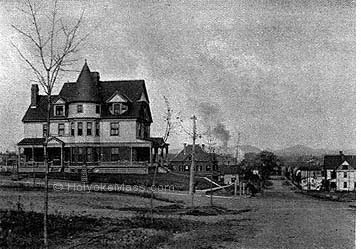
Oak Street from Corner of Essex.
|
Holyoke, as compared with other cities, is remarkably fortunate in its towers and spires and their placing. Rarely can be found a place where from so many points of view these features of architecture loom up so handsomely. First in importance is the tower of the City Hall, which from near or far is never lost to sight. Whether viewed from the streets below or glimpsed up a narrow alley, or seen from the hills westerly, or from the east across the river, it never loses its attraction and is always a central point of interest.
The well-proportioned spire of St. Jerome’s, too, makes an attractive landmark, seen across the park it fronts, or from above or below, or any of the near streets, and the whole mass of the church is quite interesting, seen from the rear across an open lot. It is as well an attractive feature of the city, when you look south from up the river, or west from the South Hadley shores.
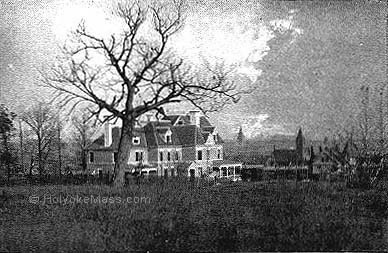
McElwain House — Linden Street.
|
The new French church, fronting Prospect Park, is also interesting. It is prominently placed, and its square tower, though not lofty, is quite attractive from wherever it is viewed. On Depot hill, another example of value in landscape of church architecture is the Catholic church on Mosher street. The whole building stands well up, and its two spires make graceful outlines against the sky from all the streets and fields for half a mile about.
One block up Dwight street from the City Hall is Hampden Park, a square of lawns and winding paths and well-grown trees, with a granite monument in the center, dedicated to Holyoke’s soldiers. On warm summer days the settees, here where the foliage casts cool shadows, makes an agreeable lounging place. This is a resort for the slow trundling baby carriage, and a place for the smaller children to tumble on the grass. Under a shelter in the middle of the park is a big fountain with tin cups attached, which on days of heat and dust is a famous resort of the small people, who, so far as I observed, seem to be afflicted with a perpetual dryness and to spend most of their time there.
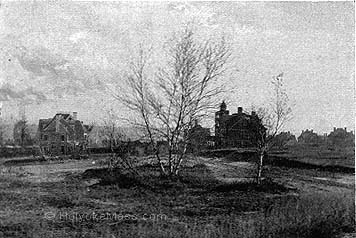
Hilltop View Near Forestdale.
|
From here a short walk takes one to a second park, which occupies a high terrace, rising steeply from the river it overlooks. Prospect Park is its appropriate name. When age gives growth to the trees which have been started, it will be much improved as an outing place; for, on hot days, people naturally seek the shade, even if they miss a beautiful view. At present a warm afternoon finds the park almost deserted, while the shadowed sidewalks and doorways of the near streets are quite crowded. Close below the park is the dam, to which is due almost altogether the city’s existence and continued prosperity. Above, the river spreads away broad and placid; but once over the crest of the dam, it breaks into foam and becomes a white turmoil of rapids and swift, rough waters, that do not regain their former composure for a mile or more. Across the river are gradually rising fields, where are several fine groves of trees, and more to the east glimpses of the spires and village houses of South Hadley Falls. But the most striking feature of the wide landscape about is Mt. Tom, whose huge bulk blots out the northern horizon. It rises blue and strong from the water’s edge in charming outline against the sky, and on quiet days mirrors itself in the glassy stream.
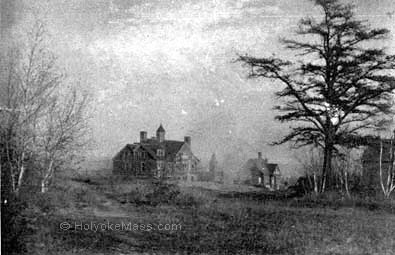
The Region Near Forestdale Cemetery.
|
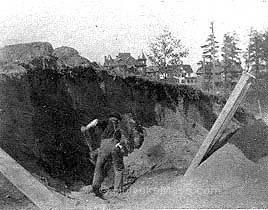
Screening Gravel.
|
© Laurel O’Donnell 1996 - 2006, all rights reserved
This document may be downloaded for personal non-commercial use only
and may not be reproduced or distributed without permission in any format.
This is an edited adaptation from the original publication.
|